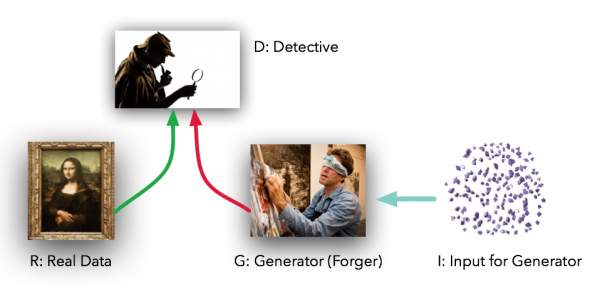
Generative Adversarial Networks (GANs) are a class of deep learning models that have become increasingly popular in recent years. GANs are a type of generative model, which means they are used to generate new data that is similar to some existing data.
The key idea behind GANs is to have two neural networks, one that generates data and another that discriminates between real and generated data. The generator network learns to generate new data that is similar to the real data, while the discriminator network learns to distinguish between real and generated data.
The two networks are trained together in a game-like fashion, with the generator network attempting to fool the discriminator network into thinking that its generated data is real, while the discriminator network attempts to correctly identify which data is real and which is generated.
The process of training a GAN involves iteratively updating the generator and discriminator networks. During each iteration, the generator network generates new data, and the discriminator network evaluates how well the generated data matches the real data. Based on this evaluation, both networks are updated to improve their performance.
One of the key advantages of GANs is that they are able to generate highly realistic data, such as images and audio, that is difficult to distinguish from real data. This has led to a wide range of applications, including image and video synthesis, data augmentation, and even game development.
Despite their successes, GANs still face a number of challenges. One of the biggest challenges is the instability of the training process, which can make it difficult to achieve good results. Additionally, GANs are often limited by the amount and quality of training data available and can suffer from mode collapse, where the generator network produces a limited set of outputs.
Top 5 Models That Use GAN
These models are just a few examples of the wide range of applications for GANs:
1- StyleGAN: StyleGAN is a state-of-the-art model for generating high-quality images that look realistic and have a consistent style. It uses GANs to generate images that match a given style and to interpolate between different styles.
2- CycleGAN: CycleGAN is a model that can learn to translate images from one domain to another, without the need for paired examples. For example, it can translate photos of horses into photos of zebras or convert summer landscapes into winter landscapes.
3- Pix2Pix: Pix2Pix is another image-to-image translation model that uses GANs. It can be used for tasks such as colorizing black and white photos, adding textures to 3D models, or turning sketches into realistic images.
4- StarGAN: StarGAN is a model for image-to-image translation that can perform multiple tasks at once. For example, it can change the age, gender, or expression of a face in an image, or even change the breed of an animal in a photo.
5- DeepFakes: DeepFakes are a controversial application of GANs that are used to create realistic videos of people saying or doing things that they never actually did. While this technology has the potential to be used for entertainment or education, it also raises concerns about the potential for malicious use.
As the technology continues to improve, we can expect to see even more exciting and innovative uses of GANs in the future.
In summary, GANs are a powerful and exciting area of research in deep learning, with many potential applications in a variety of fields. While there are still challenges to be addressed, the development of GANs has already opened up new possibilities for generating and manipulating data in innovative ways.